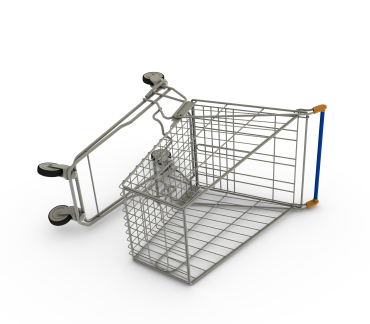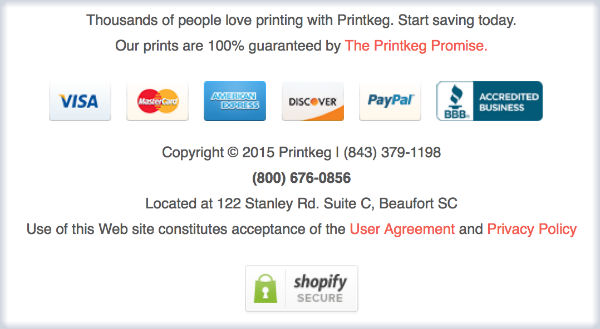
When viewing cart abandonment in the orders area of Shopify, I often cringe because I just can’t help myself from tallying up those “missed” dollars. Cart abandonment is the reality of e-commerce so don’t let it drive you too crazy. Fortunately, we are going to outline and share some effective methods that our company implements to reduce cart abandonment.

WHY DO PEOPLE ABANDON THEIR CARTS?
According to Baymard Institute, Shopping cart abandonment rates for online retailers varies between 60% and 80%, with an average of 67.91%.
The top reasons for cart abandonment are:
- Complicated checkout process
- Hidden prices come out at the time of checkout, like taxes or high shipping charges.
- Arduous or lengthy registration process. No option to check out without signing up.
- Limited payment options.
More reasons for cart abandonment
- High shipping rates
- Not ready to purchase
- Comparing prices
- The product price was high
- shipping rates were too late during the checkout process
- Doesn’t want to register
- The site is asking for too much information
- Checkout is too long or complicated
- The website is too slow
- Need more information about the product
———–
WAYS TO IMPROVE CART ABANDONMENT
Email those lost customers quickly
Professional and unlimited plans in Shopify allow store owners to email cart abandonment prospects in 6 hours or 24 hours. We go with the 6 hours.

Improve the cart abandonment email
Combining great copy, extra discounts, an excellent design, and surveys can be pivotal in saving customers and understanding why they are leaving. Dan Wang at Shopify provides incredible insight in his 13 Amazing Abandoned Cart Emails article.
Use discount codes
Many online companies include a 10 to 20% discount code (10 being the most common) in cart abandonment emails. Our business does not participate in this strategy for a couple reasons, but if you are losing tons of sales, I recommend adopting this technique at least until you’ve garnered a base of recurring customers.
Reduce shipping costs
Mark MacDonald at Shopify briefly describes three strategies of charging customers for shipping which include free shipping, flat rate shipping, and charging actual rates. Our business cannot afford free shipping for everything, but if your products are light in weight, then strongly consider doing so. If free shipping doesn’t make sense, try finding a happy medium for profit margins and improved conversion rates.
Here’s what we did:
– Free shipping for orders over $250.
– $4.99 – $9.99 flat shipping rates for orders between $100 and $249.99.
– 10% discounts on all UPS and USPS transit methods for orders under $100.
USPS helps our customers pay less for lightweight packages (5 pounds and under), while UPS is far cheaper for heavier boxes. We initially tried free shipping for all orders over $100, but it wiped out the profit. Every business is different.
Provide more payment options
Shopify’s core payment processor accepts all major credit cards (Visa, Mastercard, American Express), but many people prefer to use Paypal. Our company has found no real correlation between Paypal and conversions (although many customers choose to pay with it). Yet, research shows accepting Paypal can increase sales by as much as 20%. Remember, checkout complexity is also a reason for abandonment, so be careful when adding too many payment options. Our company recently added Google Wallet to the mix, and we are still testing its impact.

Allow guest and member checkout.
This is a simple change to make in the Shopify administrative panel. Under “settings” then “checkout” be sure the option “accounts are optional” is checked. Some third-party apps will want you to change this, but I recommend sticking with this setting no matter what. Some customers want to checkout as guests, while others want to create an account and track past orders. Customers who wish to create an account can easily do so after they complete an order, a practice well-known to improve abandonment.

Embrace email marketing.
Mailchimp and Soundest (my favorite) are only two of the many email marketing apps that place nice with Shopify. We do not email our customers daily, but we do email them a few times every month and more so while a current order is open. This traditional means of digital marketing is essential to maintain communications with current and past customers. We email clients when they haven’t shopped in six months, welcome new customers, ask for feedback, email about huge sales, and offer recommendations. Email is also utilized by our print company for keeping customers informed about the order process and shipment tracking. All this is to instill trust in future orders and convince past non-buying visitors to return if they abandoned a previous cart.
Use a cart exit pop-up.
I hate using pop-ups for anything, so Printkeg does not implement this strategy. However, if we were a different business type, we might need to be more aggressive. Pop-ups can address multiple factors of cart abandonment: perception of price, the urgency to buy quickly, return policy, and customer trust. They also offer one last chance to convince the customer to complete an order.
Reinforce security and privacy.
Shopify helps its shop owners by including links to the privacy policy, refund policy, and service terms in the checkout process’s footer area. At the bottom of every page of our website, we present a “Shopify is Secure” image and links to our privacy policy, 100% guarantee, and user agreement. These simple additions will lead to more credibility and consumer trust.

Show off your guarantee.
Frankly, consumers demand a 100% guarantee from online stores. That’s just the nature of the beast in a world of Amazon, Walmart, and Zappos. In the print industry, we must compete with the likes of Moo, Vista Print, and Uprinting – all companies that offer a 100% satisfaction guarantee. Although I would argue our “Printkeg Promise” is better since it is hassle-free, the main point is you must relay your guarantee and refund policy in a very conspicuous manner (as seen in the above image).
Provide customer support.
Our print company, Printkeg, hosts a support center, provides toll-free and local phone numbers, and our website includes a detailed contact page. Consider live chat, a help desk system, speedy email replies, and phone answering. I cannot tell you how many people have called in with a couple quick questions before finishing an order. These questions also help us determine what information should be available during checkout allowing us to decrease customer uncertainty. We also use social networking for support rather than advertising, but more on that later.
Use positive language.
Avoid saying “No” or “Don’t” and other negative phrases. If you need people to follow strict protocols, try to relay that positively before the checkout process. For instance, instead of saying, “American Express not accepted,” you could say, “We happily accept Visa and Mastercard,” which keeps the experience friendly while essentially saying the same thing. Use this type of thinking when creating copy throughout your website. For sales copy, 9 Simple Ways to Write Product Descriptions that Sell by Mark MacDonald is also a great read.
Be easy on the bells and whistles.
When adding functionality to your website, be strict and remember that everything and anything can become distracting to consumers. Some Shopify apps may sound amazing, but be extremely skeptical of their usefulness. Also, when added together, Shopify apps can become cumbersome to overall website speed, resulting in lost customers.
Social networking builds trust.
Many companies have Facebook pages, Twitter accounts, and Instagram profiles. Those places mean diddly if no one is engaging and updating. I’m out of there if I go to a website to buy goods and they only have two Facebook likes. If you are on Facebook, do a little paid advertising and gain followers to gain instant credibility (heck, you may attract some new sales too). Try not to link to social networks from your website that is not being updated since this could cause a negative outlook and more cart abandonment. Social networks are also valuable tools for support: customers in checkout mode will sometimes use those avenues to ask questions before completing an order.
Conclusion
Cart abandonment is simply a reality of any e-commerce website. However, the aforementioned methods will significantly improve cart abandonment rates for almost any website – especially Shopify stores.


